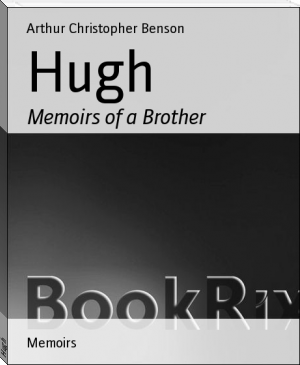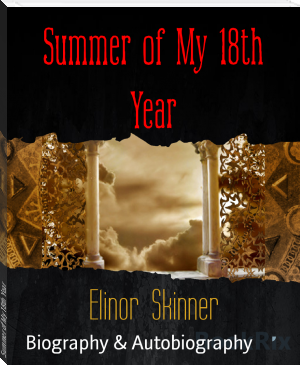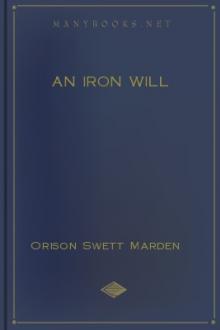Hugh by Arthur Christopher Benson (best ebook reader for ubuntu .txt) 📕

- Author: Arthur Christopher Benson
Book online «Hugh by Arthur Christopher Benson (best ebook reader for ubuntu .txt) 📕». Author Arthur Christopher Benson
But there is more than I can see,
And what I see I leave unsaid,
Nor speak it, knowing Death has made
His darkness beautiful with thee.
1916
PREFACE
This book was begun with no hope or intention of making a formal and finished biography, but only to place on record some of my brother's sayings and doings, to fix scenes and memories before they suffered from any dim obliteration of time, to catch, if I could, for my own comfort and delight, the tone and sense of that vivid and animated atmosphere which Hugh always created about him. His arrival upon any scene was never in the smallest degree uproarious, and still less was it in the least mild or serene; yet he came into a settled circle like a freshet of tumbling water into a still pool!
I knew all along that I could not attempt any account of what may be called his public life, which all happened since he became a Roman Catholic. He passed through many circles--in England, in Rome, in America--of which I knew nothing. I never heard him make a public speech, and I only once heard him preach since he ceased to be an Anglican. This was not because I thought he would convert me, nor because I shrank from hearing him preach a doctrine to which I did not adhere, nor for any sectarian reason. Indeed, I regret not having heard him preach and speak oftener; it would have interested me, and it would have been kinder and more brotherly; but one is apt not to do the things which one thinks one can always do, and the fact that I did not hear him was due to a mixture of shyness and laziness, which I now regret in vain.
But I think that his life as a Roman Catholic ought to be written fully and carefully, because there were many people who trusted and admired and loved him as a priest who would wish to have some record of his days. He left me, by a will, which we are carrying out, though it was not duly executed, all his letters, papers, and manuscripts, and we have arranged to have an official biography of him written, and have placed all his papers in the hands of a Catholic biographer, Father C. C. Martindale, S.J.
Since Hugh died I have read a good many notices of him, which have appeared mostly in Roman Catholic organs. These were, as a rule, written by people who had only known him as a Catholic, and gave an obviously incomplete view of his character and temperament. It could not well have been otherwise, but the result was that only one side of a very varied and full life was presented. He was depicted in a particular office and in a specific mood. This was certainly his most real and eager mood, and deserves to be emphasized. But he had other moods and other sides, and his life before he became a Catholic had a charm and vigour of its own.
Moreover, his family affection was very strong; when he became a Catholic, we all of us felt, including himself, that there might be a certain separation, not of affection, but of occupations and interests; and he himself took very great care to avoid this, with the happy result that we saw him, I truly believe, more often and more intimately than ever before. Indeed, my own close companionship with him really began when he came first as a Roman Catholic to Cambridge.
And so I have thought it well to draw in broad strokes and simple outlines a picture of his personality as we, his family, knew and loved it. It is only a _study_, so to speak, and is written very informally and directly. Formal biographies, as I know from experience, must emphasise a different aspect. They deal, as they are bound to do, with public work and official activities; and the personal atmosphere often vanishes in the process--that subtle essence of quality, the effect of a man's talk and habits and prejudices and predispositions, which comes out freely in private life, and is even suspended in his public ministrations. It would be impossible, I believe, to make a presentment of Hugh which could be either dull or conventional. But, on the other hand, his life as a priest, a writer, a teacher, a controversialist, was to a certain extent governed and conditioned by circumstances; and I can see, from many accounts of him, that the more intimate and unrestrained side of him can only be partially discerned by those who knew him merely in an official capacity.
That, then, is the history of this brief Memoir. It is just an attempt to show Hugh as he showed himself, freely and unaffectedly, to his own circle; and I am sure that this deserves to be told, for the one characteristic which emerges whenever I think of him is that of a beautiful charm, not without a touch of wilfulness and even petulance about it, which gave him a childlike freshness, a sparkling zest, that aerated and enlivened all that he did or said. It was a charm which made itself instantly felt, and yet it could be hardly imitated or adopted, because it was so entirely unconscious and unaffected. He enjoyed enacting his part, and he was as instinctively and whole-heartedly a priest as another man is a soldier or a lawyer. But his function did not wholly occupy and dominate his life; and, true priest though he was, the force and energy of his priesthood came at least in part from the fact that he was entirely and delightfully human, and I deeply desire that this should not be overlooked or forgotten.
A. C. B.
Tremans, Horsted Keynes,
December 26, 1914.
CONTENTS
I
HARE STREET
Garden--House--Rooms--Tapestry--Hare Street Discovered--A Hidden Treasure
II
CHILDHOOD
Birth--The Chancery--Beth
III
TRURO
Lessons--Early Verses--Physical Sensitiveness--A Secret Society--My Father--A Puppet-Show
IV
BOYHOOD
First Schooldays--Eton--Religious Impressions--A Colleger
V
AT WREN'S
Sunday Work--Artistic Temperament--Liturgy--Ritual--Artistic Nature
VI
CAMBRIDGE
Mountain--climbing--Genealogy--Economy--Hypnotism--The Call--My Mother--Nelly
VII
LLANDAFF
Dean Vaughan--Community Life--Ordained Deacon
VIII
THE ETON MISSION
Hackney Wick--Boys' Clubs--Preaching--My Father's Death
IX
KEMSING AND MIRFIELD
Development--Mirfield--The Community--Sermons--Preaching
X
THE CHANGE
Leaving Mirfield--Considerations--Argument--Discussion--Roddy--Consultation
XI
THE DECISION
Anglicanism--Individualism--Asceticism--A Centre of Unity--Liberty and Discipline-- Catholicism--The Surrender--Reception--Rome
XII
CAMBRIDGE AGAIN
Llandaff House--Our Companionship--Rudeness--The Catholic Rectory--Spiritual Direction--Mystery-Plays--Retirement
XIII
HARE STREET
Ken--Engagements--Christmas--Visits
XIV
AUTHORSHIP
The Light Invisible--His Books--Methods of Writing--Love of Writing--The Novels
XV
FAILING HEALTH
Illness--Medical advice--Pneumonia
XVI
THE END
Manchester--Last Illness--Last Hours--Anxiety--Last Words--Passing on
XVII
BURIAL
His Papers--After-Thoughts--The Bond of Love
XVIII
PERSONAL CHARACTERISTICS
Courage--Humour--Manliness--Stammering-- Eagerness--Independence--Forward
XIX
RETROSPECT
Boyhood--Vocation--Independence--Self-Discipline
XX
ATTAINMENT
Priesthood--Self-Devotion--Sympathy--Power--Energy
XXI
TEMPERAMENT
Courtesy--Chivalry--Fearlessness--Himself
"Then said _Great-heart to Mr. Valiant-for-Truth, Thou hast
worthily behaved thyself. Let me see thy Sword. So he shewed it
him. When he had taken it in his hand, and looked thereon a while,
he said, Ha, it is a right Jerusalem Blade!"
The Pilgrim's Progress.
HUGH
I
HARE STREET
How loudly and boisterously the wind roared to-day across the low-hung, cloud-smeared sky, driving the broken rack before it, warm and wet out of the south! What a wintry landscape! leafless trees bending beneath the onset of the wind, bare and streaming hedges, pale close-reaped wheat-fields, brown ploughland, spare pastures stretching away to left and right, softly rising and falling to the horizon; nothing visible but distant belts of trees and coverts, with here and there the tower of a hidden church overtopping them, and a windmill or two; on the left, long lines of willows marking the course of a stream. The road soaked with rain, the grasses heavy with it, hardly a human being to be seen.
I came at last to a village straggling along each side of the road; to the right, a fantastic-looking white villa, with many bow-windows, and an orchard behind it. Then on the left, a great row of beeches on the edge of a pasture; and then, over the barns and ricks of a farm, rose the clustered chimneys of an old house; and soon we drew up at a big iron gate between tall red-brick gateposts; beyond it a paling, with a row of high lime trees bordering a garden lawn, and on beyond that the irregular village street.
From the gate a little flagged pathway leads up to the front of a long, low house, of mellow brick, with a solid cornice and parapet, over which the tiled roof is visible: a door in the centre, with two windows on each side and five windows above--just the sort of house that you find in a cathedral close. To the left of the iron gate are two other tall gateposts, with a road leading up to the side of the house, and a yard with a row of stables behind.
Let me describe the garden first. All along the front and south side of the house runs a flagged pathway, a low brick wall dividing it from the lawn, with plants in rough red pots on little pilasters at intervals. To the right, as we face the door, the lawn runs along the road, and stretches back into the garden. There are tall, lopped lime-trees all round the lawn, in the summer making a high screen of foliage, but now bare. If we take the flagged path round the house, turn the corner, and go towards the garden, the yew trees grow thick and close, forming an arched walk at the corner, half screening an old irregular building of woodwork and plaster, weather-boarded in places, with a tiled roof, connected with the house by a little covered cloister with wooden pillars. If we pass that by, pursuing the path among the yew trees, we come out on a pleasant orchard, with a few flower-beds, thickly encircled by shrubs, beyond which, towards the main road, lies a comfortable-looking old red-brick cottage, with a big barn and a long garden, which evidently belongs to the larger house, because a gate in the paling stands open. Then there is another little tiled building behind the shrubs, where you can hear an engine at work, for electric light and water-pumping, and beyond that again, but still connected with the main house, stands another house among trees, of rough-cast and tiles, with an open wooden gallery, in a garden of its own.
In the orchard itself is a large grass-grown mound, with a rough wooden cross on the top; and down below that, in the orchard, is a newly-made grave, still covered, as I saw it to-day, with wreaths of leaves and moss, tied some of them with stained purple ribbons. The edge of the grave-mound is turfed, but the bare and trodden grass shows that many feet have crossed and recrossed the ground.
The orchard is divided on the left from a further and larger garden by a dense growth of old hazels; and passing through an alley you see that a broad path runs concealed among





Comments (0)